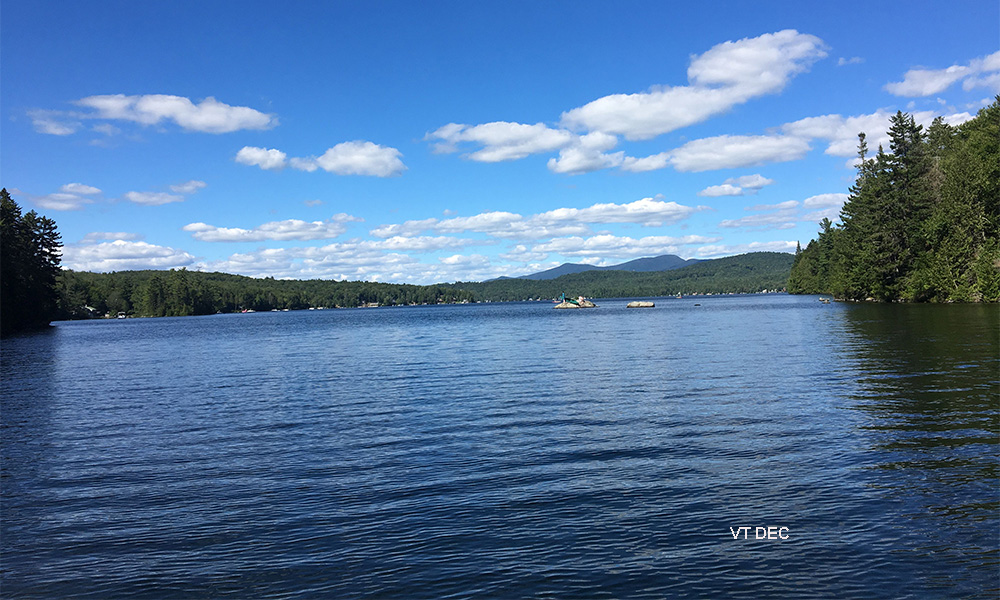Tracking the Health of 823 Vermont Inland Lakes
Oct. 20th 2020When considering lakes in Vermont, the first lake that likely comes to mind for most people is Lake Champlain. With 587 miles of shoreline shared by Vermont, New York, and part of Quebec, and about 64 total public/commercial and private beaches, the lake has great recreational value. Not to mention, 571,000 people live within the Lake Champlain basin, 200,000 of whom depend on the lake for drinking water. With so many people living near and using the lake, it is not a surprise that there is a lot of research concerning the health of Lake Champlain.
But did you know that Vermont also has more than 800 inland lakes scattered throughout the state? Understanding the health of these lakes is just as important for their management and to ensure safe use and access for Vermont residents and visitors alike. About a third, or 300, of these lakes are larger than 20 acres, and many are used for recreational boating and fishing.
The Vermont Lakes and Ponds Management and Protection Program (VLPP) developed the Vermont Inland Lake Score Card to make lake health data publicly available and accessible for 823 of Vermont’s inland lakes. This data can be accessed in two ways, either by using Google Earth Pro or through the webpage. The map and data repository highlight four key factors of lakes: 1) nutrient trends, 2) aquatic invasive species, 3) shoreland and lake habitat, and 4) mercury pollution.
Individual lakes have an associated “Score Card” which shows the status of each of these four health factors. The scores for each health factor are determined by a variety of metrics, including water quality data collected from each respective lake. Score thresholds for differentiating scores are based on professional judgment, and VLPP scientists review final scores. For a detailed description of how lake scores are determined, read the “How Lakes Are Scored” report provided by VLPP and linked in the Lake Score Card page. Or, watch the webinar detailing the scoring methodology as well as some findings about phosphorus trends in Vermont lakes that grew out of VLPP work in developing the score card.
Within the interface on Google Earth, users can click on a score card for any one of the 823 lakes, displayed on the map by lake name. On the score card itself, each health factor is defined as “Good,” “Fair,” or “Poor” condition, or noted as “Insufficient Data” if not enough data were available to determine health status. These score cards are displayed on the map in the shape of a Secchi disk (a black and white circular piece of equipment used to measure water clarity), color coded according to condition: blue for good, yellow for fair, red for poor, and gray for insufficient data. The score card also includes embedded links so users can view more detailed information and underlying data for each measurement of lake health.
The score card makes a distinction between trends and statuses for lakes. The “Water Quality” score is based on trends, specifically whether phosphorus, Secchi and/or Chlorophyll-a is increasing over time.
“We designed this score as kind of an alert system to inspire action by the lake community to address issues leading to deteriorating conditions,” said Leslie Matthews, Environmental Scientist with Vermont Department of Environmental Conservation and co-creator of the Score Card.
There is also a status core which reflects current condition. For example, Lake Carmi has a “Good” trend score because it is not getting worse. However, its status score is “Impaired” because the water quality is low, as well as other issues. There is also a Watershed Score that reflects the amount of human disturbance in the watershed which could negatively impact the lake.
At present, the scores and data displayed via the Google Earth interface and web pages are current through 2019. The Vermont Lakes and Ponds Program collects most of the data during the summer months, processing and analyzing the data during the winter months, with a goal to update the score card annually. Each update generally occurs in the early part of the year after it was collected.
The goal of the lake score card is to provide easy to understand information and graphics to answer the question, “how is a lake doing?” so users can readily determine the health of a particular lake. With so many lakes throughout the state, the Vermont Inland Lake Score Card is of great value to those wishing to learn a bit more about the status of Vermont’s inland lakes.
For those people who may be interested in getting involved to protect a lake’s “good” score, or to help restore a lake with a “fair” or “poor” score, the VLPP also provides a “Checklist of Lake Protection Actions" at the bottom of the Lake Score card page. The document provides links to additional information related to assessments of lake health, such as Best Management Practices (BMPs), the Vermont Lay Monitoring Program, and how to identify cyanobacteria blooms. If you live near or recreate at any of Vermont’s inland lakes, be sure to check out the list of lake protection actions and the Vermont Inland Lake Score Card!
 ecoNEWS VT
ecoNEWS VT